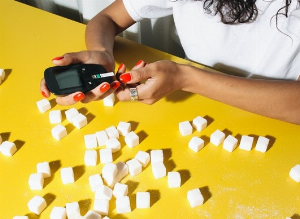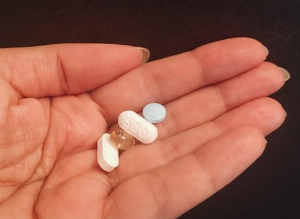Diabetes: hypoglycaemia, hyperglycaemia and ketoacidosis - everything you need to know!
Published 22 Apr 2022 • By Candice Salomé
In people with diabetes, insulin production is deficient or non-existent. This leads to abnormal variations in blood sugar levels. When the amount of sugar in the blood is too high, it is called hyperglycaemia. Conversely, when the amount of sugar in the blood is too low, it is called hypoglycaemia. Ketoacidosis is an increase in blood acidity due to an insufficient dose of insulin, compared to the patient's needs.
So what are the symptoms of hypoglycaemia, hyperglycaemia and ketoacidosis? What should you do in you are affected?
We explain it all in our article!

What is hypoglycaemia and what are its symptoms?
Causes
Hypoglycaemia means that blood sugar levels are too low, i.e. below 0.7 g/L.
Hypoglycaemia occurs mainly in people who are being treated with such medications as sulphonamides, glinides and insulin. These can cause blood sugar levels to drop too low.
However, a sudden drop in blood sugar levels can also occur in other circumstances.
For example, medication doses may become inappropriate as the disease progresses.
But hypoglycaemia may also occur in situations which are more related to lifestyle changes.
For example:
- A change in eating habits. Indeed, skipping meals, eating later than usual or eating a meal that is lighter than usual or does not contain enough starch, could lead to hypoglycaemia,
- Increased or unplanned physical activity can also lead to hypoglycaemia,
- Taking a non-diabetic medication that lowers blood glucose levels,
- A change in diabetes treatment,
- A mistake in the dosage of insulin or other diabetes medication,
- Or drinking certain types of alcohol such as whisky, gin or vodka.
Symptoms
Symptoms of hypoglycaemia may include:
- Sweating, mild nausea, paleness, abnormal hunger,
- Nervousness, palpitations, irritability or trembling,
- Tingling or pins and needles in the area around the mouth,
- Headache, blurred vision, dizziness,
- Loss of balance, feeling weak,
- A feeling of anxiety and increased heart rate.
All of these symptoms may become worse and lead to lack of concentration, difficulty speaking, confusion, muscle twitching or mood disorders. In rarer cases, hypoglycaemia can cause seizures or loss of consciousness.
What to do?
In the event of hypoglycaemia, you should :
- Quickly eat something that contains sugar: it should be an equivalent of 15 grams, or 3 lumps of white sugar. Be careful not to eat too much sugar too quickly, as this can lead to hyperglycaemia. Eating fast-acting carbohydrates (such as limps of sugar or sweets) can be followed by a meal of slow-release carbohydrates, in order to restore blood sugar levels in the long term,
- Sit or lie down for a few minutes.
If the patient has a blood glucose meter, self-monitoring allows him/her to confirm (or not) an episode of hypoglycaemia and thus to be able to monitor its evolution.
If you do not notice any improvement or if you do not know what to do in case of hypoglycaemia, contact your doctor as quickly as possible. In some cases, your doctor may prescribe medication (glucagon) in the form of injection, to be administered by someone close to you, if hypoglycaemia persists despite a sufficient intake of carbohydrates.
If the situation worsens, call 999 immediately.
In addition, it is highly recommended that you always carry with you a list of all the treatments you are taking.
What is hyperglycaemia and what are its symptoms?
Causes
Certain situations can cause an increase in blood sugar levels even when diabetes is well controlled. These are called hyperglycaemic episodes, and are characterised by fasting blood sugar levels being greater than or equal to 1.10 g/L.
Hyperglycaemia can occur in the following situations:
- Missing your insulin injection or taking medication irregularly,
- Contracting an infection,
- Taking medication that increases blood sugar levels,
- Suffering from severe stress.
Symptoms
If hyperglycaemia is significant, the body will try to eliminate the excess of sugar.
The manifestations of hyperglycaemia are as follows:
- More urgent need to urinate,
- An increase in the amount of urine, that can cause a significant loss of water, which in its turn can lead to dehydration. Dehydration results in severe thirst, dry mouth, sometimes even blurred vision or severe fatigue.
These symptoms can appear quickly or develop for several days.
In some more serious cases, patients may suffer from impaired consciousness which can sometimes progress to coma.
What to do?
In the event of hyperglycaemia, you need to drink enough to compensate for the loss of water. It is essential to drink water and not sugary drinks.
If your blood sugar level is still high or too high, or if you are not sure what to do in the event of a hyperglycaemic episode, contact your doctor.
If you have a blood glucose meter, it is recommended that you perform several self-monitoring tests. This will allow you to confirm high blood sugar level and monitor its progress.
If the situation seems to be getting worse, call 999.
If you have experienced one or more episodes of hyperglycaemia, it is important to tell your doctor about it. Make a note of the symptoms you have had and the circumstances in which these episodes have occurred, as well as of any questions you may want to ask your doctor.
What is ketoacidosis and what are its symptoms?
Causes
Each diabetic has his or her own treatment, adapted to his or her daily life.
In the case of type 1 diabetes, ketoacidosis is the result of an insufficient dose of insulin, compared to the patient's needs. The body will then use fat to make the energy it needs, producing ketone bodies, which are harmful.
In type 2 diabetes, ketoacidosis is less common and occurs when a disease, treatment or surgery disrupts the blood sugar balance.
Symptoms
The symptoms of ketoacidosis appear gradually:
- Intense thirst,
- Frequent urination,
- Blurred vision,
- Abnormal fatigue,
- Loss of appetite,
- Digestive problems such as abdominal pain or nausea,
- "Fruity" breath (a smell of apple),
- Night cramps,
- Respiratory discomfort,
If left untreated, the patient's condition worsens, and breathing difficulties may occur. Finally, diabetic ketoacidosis may lead to consciousness disorders, which may progress to coma or even death.
What to do?
Teaching the patient to self-monitor their blood glucose levels is essential in order to be able to identify the onset of diabetic ketoacidosis as early as possible. When blood glucose levels are abnormally high (i.e. above 2.5 g/L of blood), a diabetic patient should do routine tests for the presence of ketones in the urine (using urine strips) or in the blood.
Patients with diabetic ketoacidosis are admitted to hospital.
Treatment consists of insulin, saline with glucose and potassium. Afterwards, blood glucose levels and the absence of glucose and ketones in the urine are regularly monitored. Prevention of ketoacidosis is based on the patient's adherence to insulin therapy, in order to control diabetes (without missing the doses).
Give it a "like" and share your thoughts and questions with the community in the comments below!
Take care!
Sources :
Comment faire face à une hypoglycémie ? Fédération Française des Diabétiques
Diabète : hypoglycémie, hyperglycémie et acidocétose, Ameli
Hypoglycémie, Le Manuel MSD
Comment faire face à l’hyperglycémie ? Fédération Française des Diabétiques
Les symptômes et les complications de l'acidocétose diabétique, Vidal
Le diagnostic et le traitement de l'acidocétose diabétique, Vidal
2 comments


 Facebook
Facebook Twitter
Twitter



